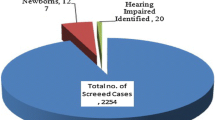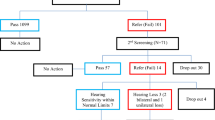Abstract
Hearing is an important sense organ for human beings essential for speech, language and overall development. Universal neonatal hearing screening programmes are mandatory in many developed countries. In India out of 1000 neonates approximately 5–6 infants are diagnosed with hearing impairment but still universal neonatal hearing screening programme is in its infancy. To screen all neonates delivered at our centre in three years, with secondary objective of determining the significance of risk factors with neonatal hearing loss and to provide appropriate intervention following the detection of a permanent hearing impairment. It is a non-randomised prospective cohort study conducted at a tertiary care centre to screen all neonates born between Jan 2017 and Dec 2019 with 2 stage protocol using distortion product otoacoustic emission and auditory brainstem response. The study population was also divided into two groups, ‘‘at risk’’ and ‘‘no risk’’ groups to determine the significance of risk factors on neonatal hearing loss. Total 2676 neonates were screened, OAE referral rate was 1.53%. There was a 94.12% follow up. The incidence of hearing impairment was found to be 7 per 1000(In the “no risk” group, 2.9 per 1000 and in the “at risk” group, 41.38 per 1000). Statistically, a significant difference was found in the incidence of hearing impairment between the two groups (p < 0.05, chi-square Test). Hospital based universal hearing screening of new born before discharge is feasible at a tertiary care centre. A high incidence of 0.7% congenital hearing impairment warrants universal newborn hearing screening programme. Considering the limitations and infrastructure in India, we should at least employ screening for all high risk neonates.

Similar content being viewed by others
References
WHO World Health Organization; [cited 2020 Oct 14]. Available from: http://www.who.int/deafness/estimates/en/
Parab SR, Khan MM, Kulkarni S, Ghaisas V, Kulkarni P (2018) Neonatal screening for prevalence of hearing impairment in rural areas. Indian J Otolaryngol Head Neck Surg 70(3):380–386
Rai N, Thakur N (2013) Universal screening of newborns to detect hearing impairment–is it necessary? Int J Pediatr Otorhinolaryngol 77(6):1036–1041
Kumar S, Mohapatra B (2011) Status of newborn hearing screening program in India. Int J Pediatr Otorhinolaryngol 75(1):20–26
Augustine AM, Jana AK, Kuruvilla KA, Danda S, Lepcha A, Paul RR et al (2014) Neonatal hearing screening—experience from a tertiary care hospital in Southern India. INDIAN Pediatr 51(3):179–183
Nagapoornima P, Ramesh A, Srilakshmi Rao S, Patricia PL, Gore M et al (2007) Universal hearing screening. Indian J Pediatr 74(6):545–549
Paul AK (2011) Early identification of hearing loss and centralized newborn hearing screening facility-the Cochin experience. Indian Pediatr 48(5):355–359
Hearing JC on I (2007) Position statement: principles and guidelines for early Hearing detection and intervention programs. Pediatrics 120(4):898–921
John M, Balraj A, Kurien M (2009) Neonatal screening for hearing loss: pilot study from a tertiary care centre. Indian J Otolaryngol Head Neck Surg 61(1):23–26
Pappas DG (1983) A study of the high-risk registry for sensorineural hearing impairment. Otolaryngol Head Neck Surg 91(1):41–44
Cordes M, Wszolek ZK (2003) Deafness and cerebral plasticity. J Nucl Med 44(9):1440–1442
Galhotra A, Sahu P (2019) Challenges and solutions in implementing hearing screening program in India. Indian J Community Med 44(4):299
Lancet T (2016) Hearing loss: an important global health concern. The Lancet 387(10036):2351
Census of India Website: Office of the Registrar general & census commissioner, India. [cited 2020 Oct 5]. Available from: https://censusindia.gov.in/
Blanchfield BB, Feldman JJ, Dunbar JL, Gardner EN (2001) The severely to profoundly hearing-impaired population in the United States: prevalence estimates and demographics. J Am Acad Audiol 12(4):183–189
Gupta S, Sah S, Som T, Saksena M, Yadav CP, Sankar MJ et al (2015) Challenges of implementing universal newborn hearing screening at a tertiary care centre from India. Indian J Pediatr 82(8):688–693
Thompson DC, McPhillips H, Davis RL, Lieu TL, Homer CJ, Helfand M (2001) Universal newborn hearing screening: summary of evidence. JAMA 286(16):2000–2010
McPherson B, Li SF, Shi BX, Tang JLF, Wong BYK (2006) Neonatal hearing screening: evaluation of tone-burst and click-evoked otoacoustic emission test criteria. Ear Hear 27(3):256–262
Sharma Y, Mishra G, Bhatt SH, Nimbalkar S (2015) Neonatal hearing screening programme (NHSP): at a rural based tertiary care centre. Indian J Otolaryngol Head Neck Surg 67(4):388–393
Akinpelu OV, Peleva E, Funnell WRJ, Daniel SJ (2014) Otoacoustic emissions in newborn hearing screening: a systematic review of the effects of different protocols on test outcomes. Int J Pediatr Otorhinolaryngol 78(5):711–717
Vignesh SS, Jaya V, Sasireka BI, Sarathy K, Vanthana M (2015) Prevalence and referral rates in neonatal hearing screening program using two step hearing screening protocol in Chennai—A prospective study. Int J Pediatr Otorhinolaryngol 79(10):1745–1747
Todd NW (2006) Universal newborn hearing screening follow-up in two Georgia populations: newborn, mother and system correlates. Int J Pediatr Otorhinolaryngol 70(5):807–815
Vaid N, Shanbhag J, Nikam R, Biswas A (2009) Neonatal hearing screening—the Indian experience. Cochlear Implants Int 10(S1):111–114
Jackler RK, De La Cruz A (1989) The large vestibular aqueduct syndrome. Laryngoscope 99(12):1238–42, Discussion 1242–1243
Doyle KJ, Sininger Y, Starr A (1998) Auditory neuropathy in childhood. Laryngoscope 108(9):1374–1377
Funding
None.
Author information
Authors and Affiliations
Corresponding author
Ethics declarations
Conflict of Interest
The authors declare that they have no conflict of interests.
Ethical Approval
Taken.
Human and Animal Rights
Research involves human Participants.
Consent to Participate
Written informed consent was taken from individual patients included in the study.
Additional information
Publisher's Note
Springer Nature remains neutral with regard to jurisdictional claims in published maps and institutional affiliations.
Rights and permissions
About this article
Cite this article
Upadhyay, K., Gupta, V., Singh, S. et al. Outcome of Universal Neonatal Hearing Screening Programme at a Tertiary Care Centre: A Prospective Study. Indian J Otolaryngol Head Neck Surg 74 (Suppl 3), 3813–3818 (2022). https://doi.org/10.1007/s12070-021-02628-3
Received:
Accepted:
Published:
Issue Date:
DOI: https://doi.org/10.1007/s12070-021-02628-3




